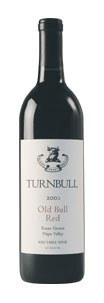 |
|
Wine Details
Price:
$20.00 per bottle
Description:
61% Cabernet Sauvignon, 17% Syrah, 9% Merlot, 4% Cabernet Franc, 3% Tempranillo, 2% Petit Syrah, 2% Sangiovese, 2% Petit Verdot
|
|
Varietal Definition
Syrah:
Syrah is the eight hundred pound gorilla of Rhone grapes! In the vineyard and the winery, Syrah is typically an easy grape to work with - healthy, early ripening, resistant to mildew and rot; suitable for winemaking in a variety of styles. The wines from Syrah are tannic without being harsh. The wines will have a taste and smell of dark blue fruit like blackberries and blackcurrant, with a strong spicy side where one can find freshly ground pepper and other spices. Syrah is famous for its part in the French blends, such as Côtes du Rhone and Châteauneuf du Pape.
|
Sangiovese:
Sanguis Jovis, the Latin origin for the varietal name, literally means “blood of Jove.” Sangiovese is one of the oldest known varietals and it is likely that ancient Etruscan winemakers cultivated it, although the first literary reference to Sangiovese was in 1722. Sangiovese is probably indigenous to Tuscany, whose most famous wine is Chianti. Chianti is a blend that currently contains a minimum of 90% Sangiovese.Sangiovese thrives in hot dry climates. Because these climatic criteria generally enhance quantity, rather than quality, it takes careful cultivation and winemaking techniques to produce really excellent wine from this grape.
|
Petite Sirah:
Petite Sirah is the same as the French variety known as Durif, a cross of Peloursin, with the true Syrah. A French nurseryman, Dr. François Durif, propagated the grape trying for resistance to powdery mildew and named it after himself, in the 1870s. Petite Sirah has long been an important blending grape, prized primarily for its deep color and fairly intense tannin. It is the variety most often chosen to blend into Zinfandel for added color, complexity, body, and to tone down the tendency of Zins toward "jammy" fruit.
|
Petit Verdot:
Petite Verdot is one of the five noble Bordeaux varietals, essentially acting as the nuts and bolts in most Bordeaux blends. With intense color and racy flavors, this wine possesses elements of pencil shavings, dark fruit presentation and a subtle complexity, which can be appreciated by even the most discerning palate.
|
Merlot:
Merlot is known as a Noble Bordeaux varietal. Although it came to France in the first century, it was not named until the 1880s. Merlot was originally used only for blending, as it is soft and compliant, very useful in softening other Bordeaux wines like Cabernets. Recently in California and Chile it became popular as a 100% varietal wine. Merlot tends to be easier to grow in a variety of soil conditions and is harvested earlier in the year than Cabernet. Although most Merlots are made to be drunk earlier, there are many with complexities of a Cabernet. Flavors of plum, black cherry, violet, chocolate and orange pair well with rich, red pasta dishes, hearty chicken dishes, and any beef combination that you fancy. The perfect match of course is chocolate. Not only does the chocolate compliment the wine and vice-versa, but the essence of both flavors linger eternally.
|
Cabernet Sauvignon:
Cabernet Sauvignon is the most widely planted and significant among the five dominant varieties in France’s Bordeaux region, as well as the most successful red wine produced in California. Though it was thought to be an ancient variety, recent genetic studies at U.C. Davis have determined that Cabernet Sauvignon is actually the hybrid offspring of Sauvignon Blanc and Cabernet Franc. Cabernet Sauvignon berries are small with black, thick and very tough skin. This toughness makes the grapes fairly resistant to disease and spoilage and able to withstand some autumn rains with little or no damage. It is a mid to late season ripener. These growth characteristics, along with its flavor appeal have made Cabernet Sauvignon one of the most popular red wine varieties worldwide.
|
Cabernet Franc:
Cabernet Franc is an accessible, spicy, herbal, dark blue grape variety that is often compared to Cabernet Sauvignon. Cabernet Franc tends to be softer and has less tannin than Cabernet Sauvignon, although the two can be difficult to distinguish. Sometimes the French refer to Cabernets, which could mean either of the two grapes. Its typical aromas include an herbaceous and pronounced peppery nose, even in ripe fruit, and something eerily like tobacco. The Cabernet Franc ripens at an earlier stage, which gives it reason to exist in the Bordeaux area. In the Loire, where we find it a lot, it gives a clear red fresh and fruity wine.
|
Tempranillo:
The Tempranillo is to Rioja what Pinot Noir is to Burgundy. By far Spain's most noble indigenous grape it has similar characteristics to the Pinot - strawberries when young, earthy vegetal when mature - and it ages very well. It ripens early ('temprana' is the Spanish for 'early') is thick-skinned and gives good colour and extract but low alcohol and acidity. In Rioja it is blended with the more fiery Garnacha and a little Mazuelo and Graciano. It is grown throughout Spain but very much as a grape for blending as opposed to a straight varietal. Outside Spain the grape is quite prolific in Argentina and to a lesser extent in California.
|
|